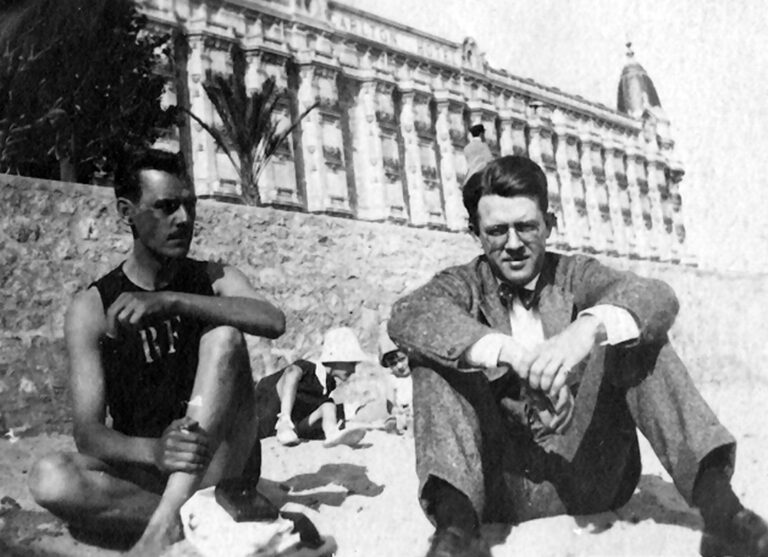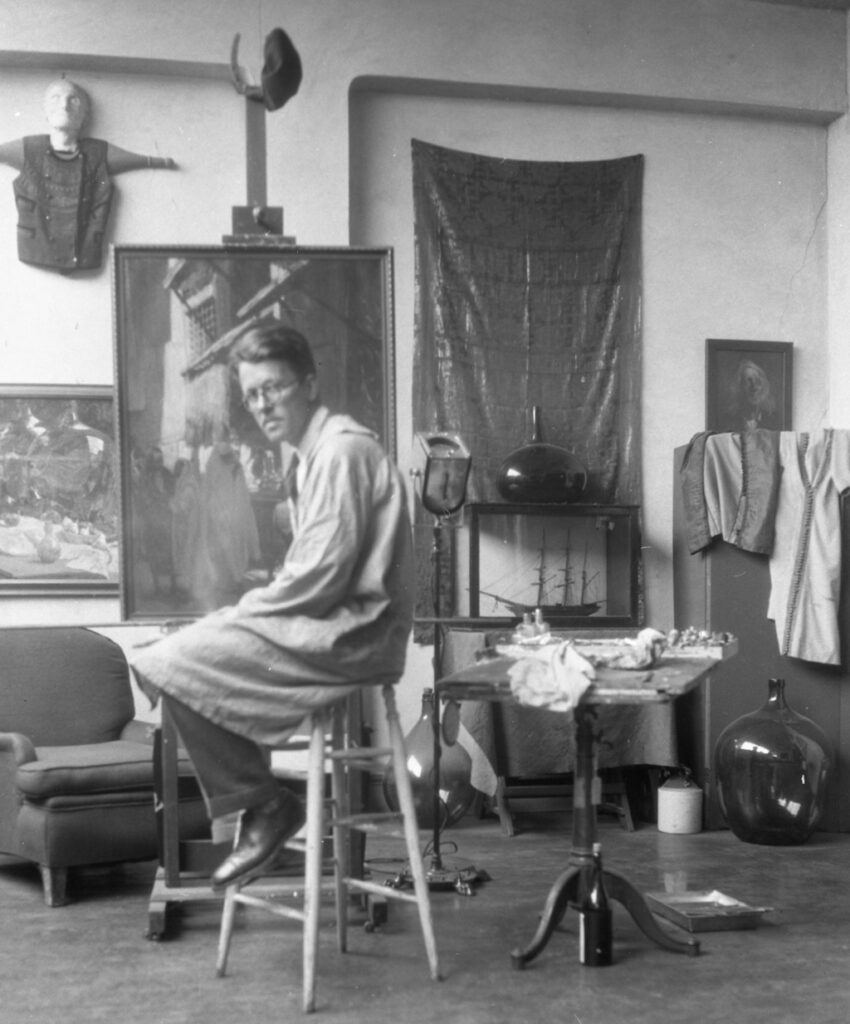Donald Teague Biography 1 (through 1923)
Edwin Donald Teague was born on November 27, 1897 in Brooklyn, New York. He was the first of two children born to Frances Ireland Teague and Edwin Dawes Teague. Edwin Sr. was an importer of English and Swiss lace. From early on, Edwin Jr. used his middle name Donald, presumably to avoid name conflict with his father.
In 1902, Donald’s brother John (Jack) Cooper Teague was born. Frances died of cancer in 1915. Edwin never remarried, and raised the boys (Jack mostly) to adulthood alone. This arrangement worked well except during summers, when school was not
in session, and also when Edwin travelled to Europe twice a year to inspect and purchase lace. Edwin leaned on family and friends to provide the needed supervision. Edwin and his two sons remained very close throughout their lives. Among other things, this allowed Donald’s father and in particular his brother Jack to serve as illustration models.


From the time he was a small boy, Donald always had a pencil in his hand, a strong interest in drawing, and an ability far beyond his years. One boyhood drawing which survives is of a three-masted frigate – in fact this drawing was one of Donald’s prized possessions in adulthood, and hung framed in his bedroom. The drawing is highly detailed and conveys action and drama. The artist was five. The signature is amusing – Donald Teague, Boy.

Donald grew up in the Flatbush neighborhood in Brooklyn. According to him, “aside from a brief and very boring time in a Saturday morning class in watercolor at Pratt Institute, I had no instruction other than the routine type in high school.” Donald attended Erasmus Hall High School in Flatbush. Founded in 1786 and initially funded by a group that included Aaron Burr, Alexander Hamilton and Robert Livingston, Erasmus Hall has a rich and storied history, and many noteworthy graduates, particularly in the arts. At Erasmus Hall, Donald continued to demonstrate considerable artistic aptitude. Two works survive from this period. The first, The Vampires, is from 1912. The second, Poster-Art, is from 1915. Both won first prizes from his art teacher.


Teague’s formal art instruction began in earnest when he enrolled at the Art Students League on West 57th Street in Manhattan. A relative upstart, Art Students League was founded in 1875. Initial board members included Thomas Eakins and Augustus Saint-Gaudens; illustrious alumni and former instructors are legion. Of his initial period at Art Students League, Teague said:
I was in life and portrait classes under Frank Vincent DuMond and George Bridgman – longer with DuMond as I wanted to get into painting as soon as possible… In the first year of study I learned drawing with charcoal and a live nude model. Then I qualified for a scholarship and the second year was devoted to painting in oil… I’ve had good reason to regret not staying with Bridgman until I could draw well, as my subsequent efforts in that department have often been frustrating. Both men, however, had a direct influence on what I hoped to do later.
While at Art Students League, Teague attended their summer school session at Woodstock, New York, where he studied landscape painting under Charles Rosen.

After two seasons at the Art Students League, Teague opined:
I thought I knew everything that it was necessary to learn, so I went out and luckily got a job. I found out in the first week that there were a lot of things I had overlooked.
Teague initially worked in art service bullpens for a year and change. He started out with Ward & Gow under Ray Greenleaf doing subway cards, posters and lettering for a salary of $15 a week. After brief service in the US Navy touring The Caribbean, Teague’s practical training resumed doing advertising work at the Frank Seaman Agency and the Welanetz Studio.
Teague’s advertising work paid well enough that he was able to save sufficient funds for his first trip abroad. In 1920, Teague set sail for England with two friends he had met at Woodstock, Clarence “Mac” McCarthy and Harold Van Doren. Van Doren went on to become a highly influential industrial designer. Over three and a half months, the trio first visited Southampton, London, and Scotland. After purchasing Raleigh bicycles and crossing the English Channel, they pedaled from Oostende through Bruges, Ghent, Brussels and Paris. From Paris they pushed into the Loire region, then veered south to Cannes. Much of the territory they encountered was only starting to recover from the ravages of war. The young men sketched and painted during the entire trip. This formative trip would prove pivotal relative to Teague’s career path – “by the time I got back home I had concluded that the advertising business was not for me and I decided to have a try at illustration.”


Upon returning to Manhattan, fortune quickly smiled twice upon Teague. First, one of his traveling companions had a friend, Edward Monks, a pen and ink artist, who needed someone to share a studio on the top floor of an old brownstone on West 37th Street. Monks decided to take Teague in. John La Gatta, who had recently moved from Cleveland, occupied the other studio on the floor. Second, Teague met Dean Cornwell. Cornwell was a highly-regarded illustrator at the time, and would go on to be considered the Dean of Illustrators by his peers. Although Cornwell was a busy practicing illustrator, he made it a point to provide feedback and advice to promising younger talent. Teague recalled:
In those early days, Cornwell rarely failed to make time to look my stuff over, despite his own very busy days and the constant knocking on his studio door of young illustrators who sought his advice. He handed down the principles of illustration promulgated by Howard Pyle and demonstrated to him by Harvey Dunn, his teacher.
The two became friends, and eventually life-long friends. Cornwell was only 5 years older than Teague, which undoubtedly facilitated the friendship. Looking back on his career, Teague reverently considered Cornwell to be his most important and valued mentor. Even in late life, Teague often cited a guiding quotation from Cornwell: “It’s an illustrator’s job to paint something neither he nor anyone else has seen, and make it appear as if he had actually been an observer on the spot.”
As Teague explained:
Several months of hard work and absolutely invaluable counsel and instruction from Dean Cornwell, produced some samples and I started making the rounds of the magazines. After wearing out a lot of shoe leather, I got my first job from a Mr. Johnson of Everybody’s Magazine, which was doing quite well then, and it was followed by a job from The Delineator – both magazines were published by Butterick Company.



Teague described the next short phase of his career as follows:
With a start like that, I thought I had nothing to worry about so, with the proceeds from these jobs, I took off for Colorado and spent several weeks on a working ranch in Yampa where I was joined by my father and brother who were meeting me there for a vacation.
Much to my dismay, when I returned to New York I found that I had to start all over again. I finally wound up working for St. Nicholas, a children’s magazine… I worked for it for a year or so and one thing I’ll never forget was the time my regular price of $25 per picture was reduced to $15 because that particular illustration showed only animals – bears as I remember it – and was therefore much less difficult to do [in the opinion of the art editor] than if it had had people in it!
Not long after that I did several illustrations for Jack Hilder of the Elks Magazine, which staved off starvation for a short time.
Teague’s Art Students League registration records indicate that he signed up in December, 1922 to attend five lectures given by a new lecturer, Dean Cornwell. In addition to lecturing, Cornwell provided feedback to participants, and expected them to bring fresh work each week for review. Each lecture cost one dollar.
Teague caught his big break in 1923 when he was approached by Arthur McKeogh, the art editor for The Saturday Evening Post. McKeogh visited Teague in his studio and gave him his first Post assignment in March. The illustration ran on April 28th. From then on, he never had to worry about having enough work.
